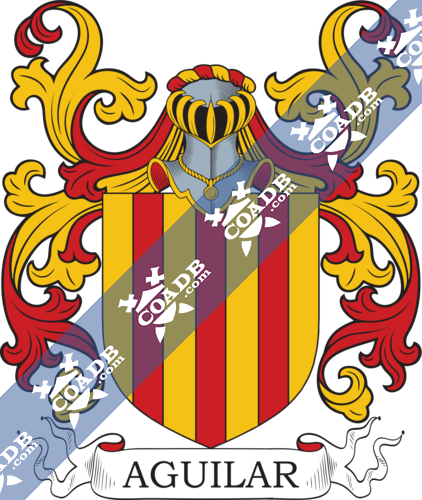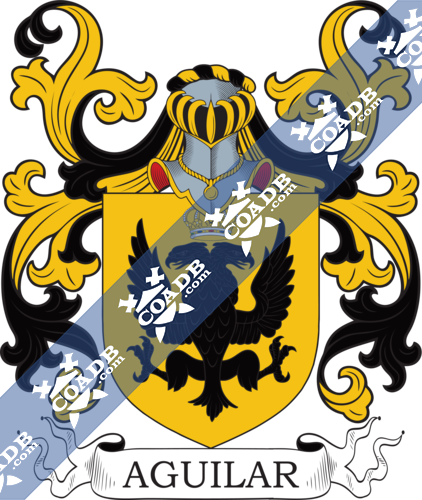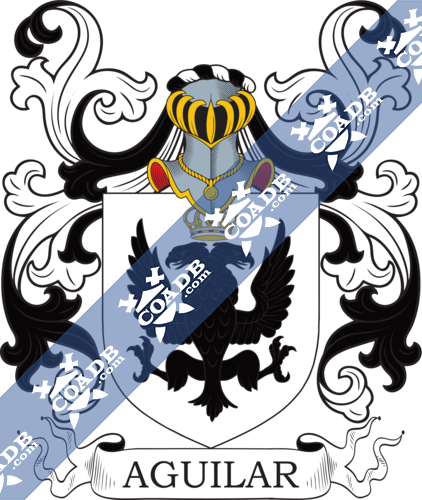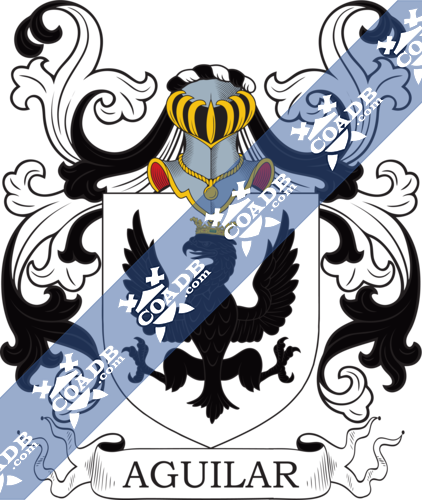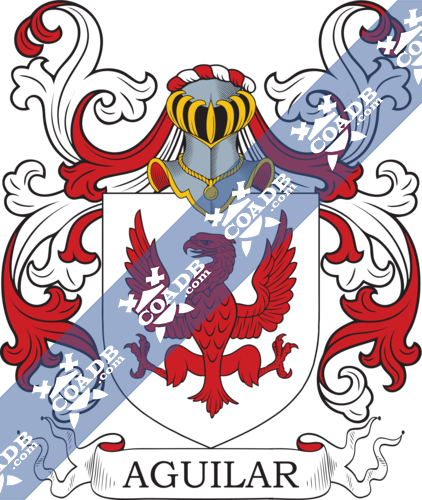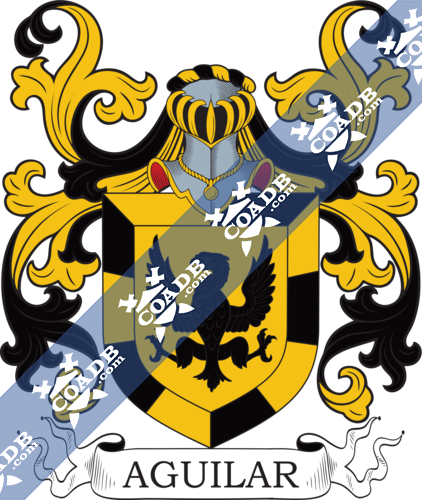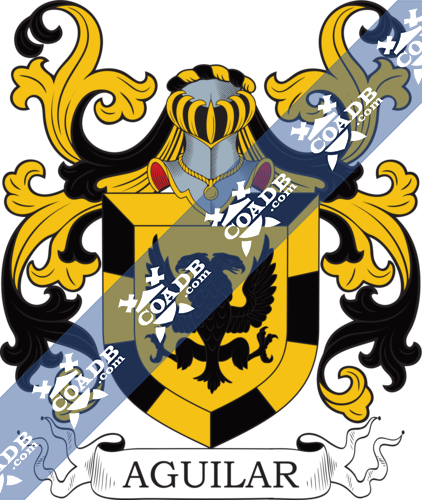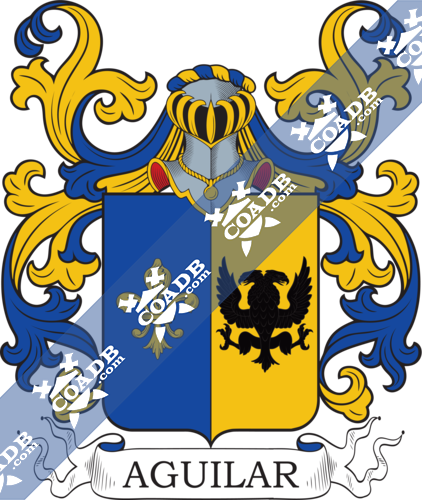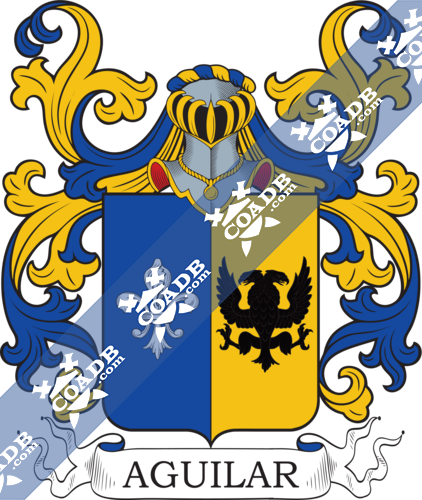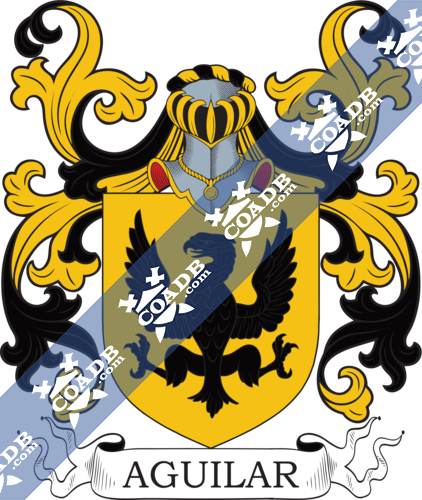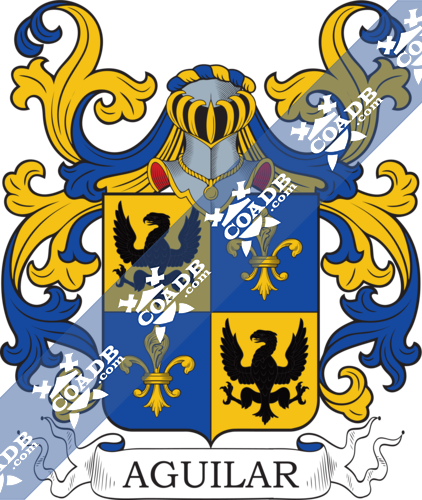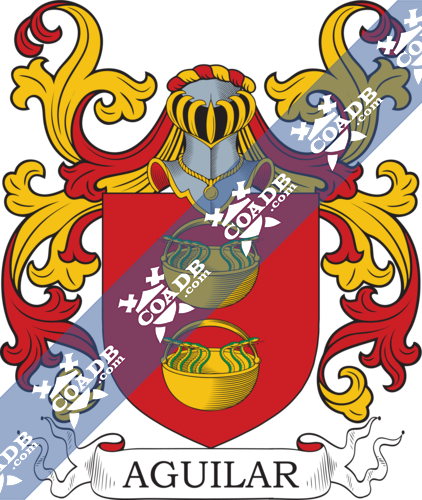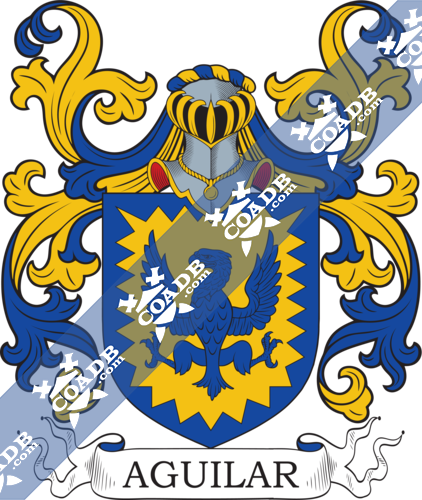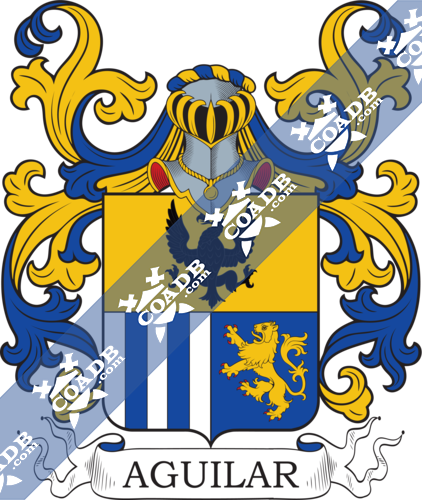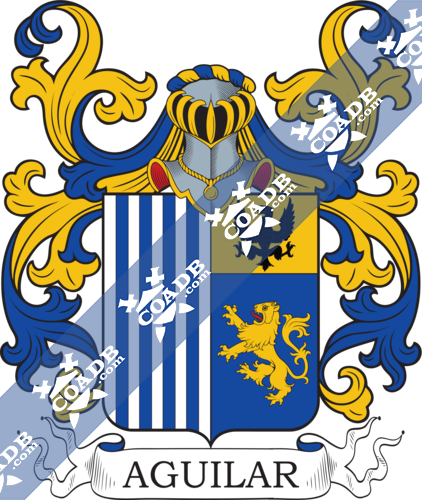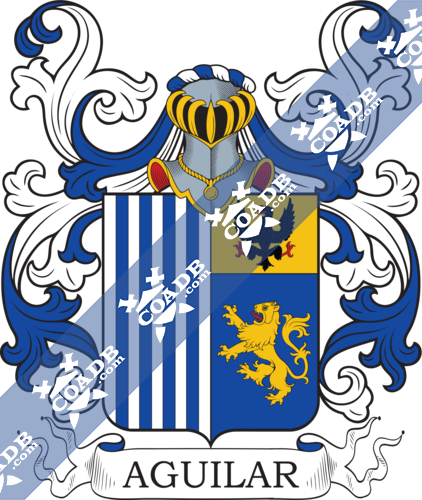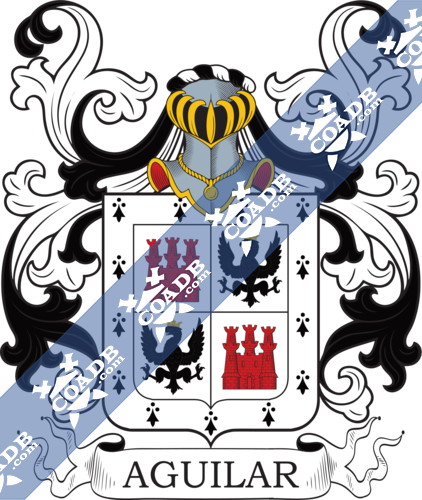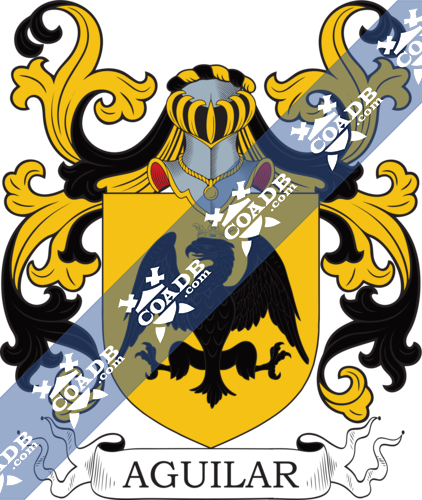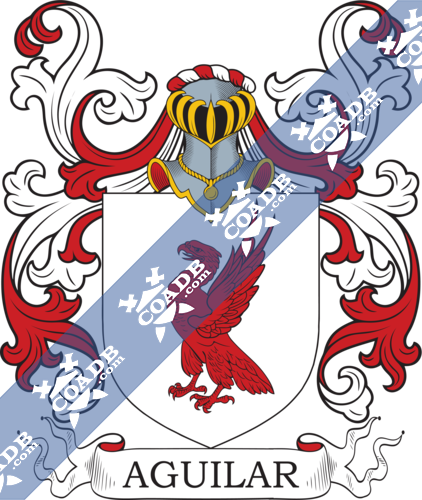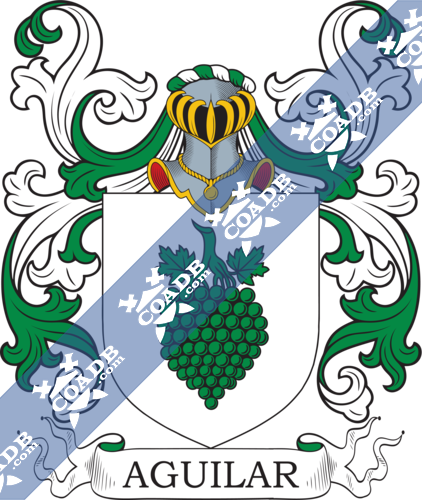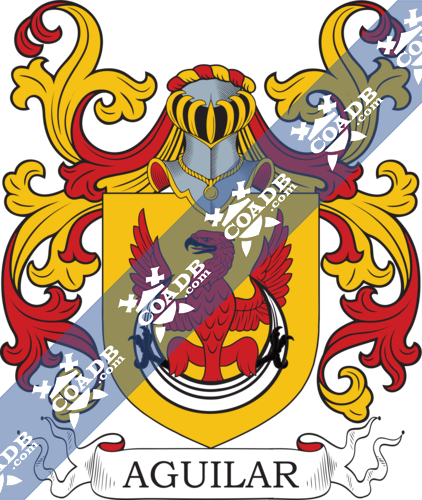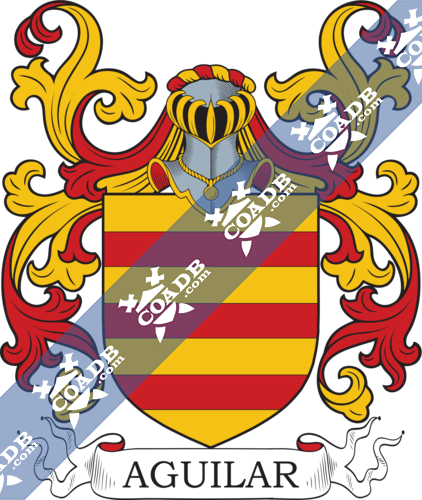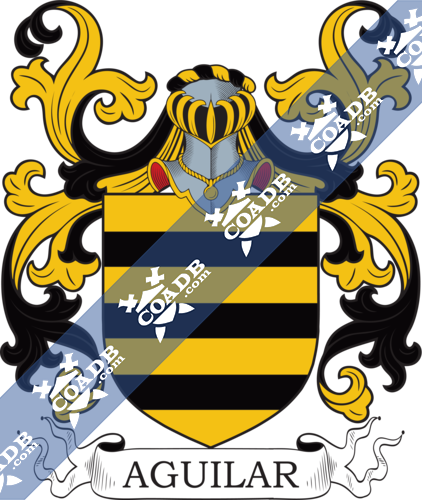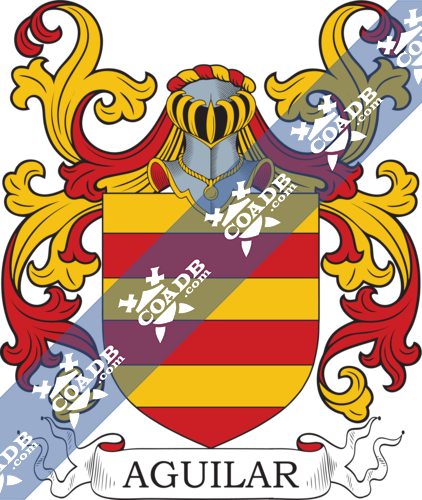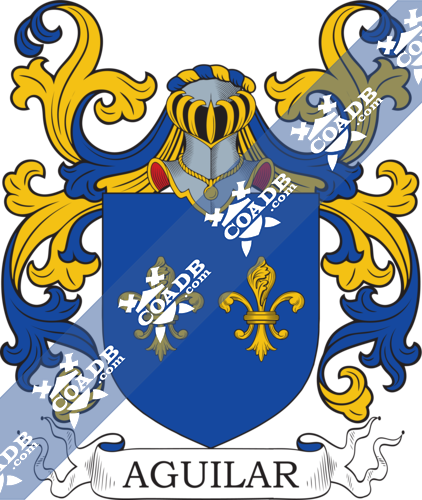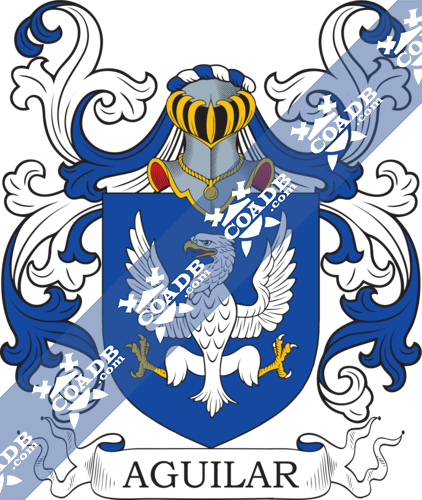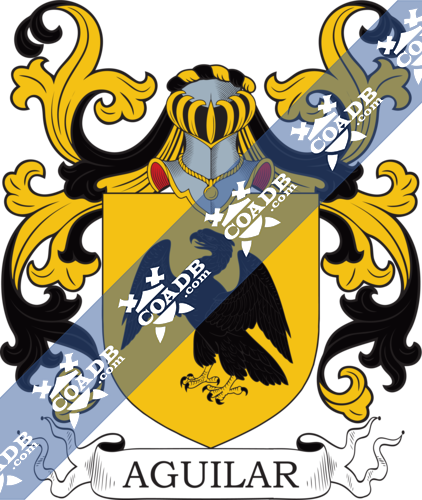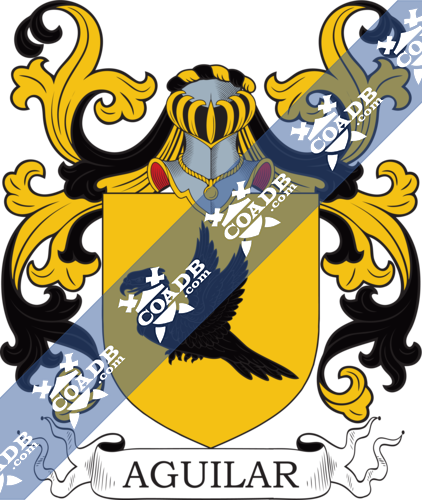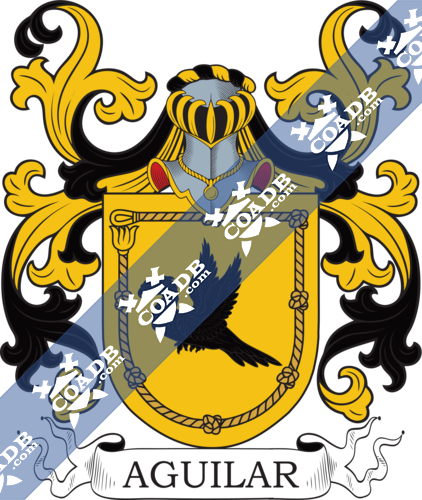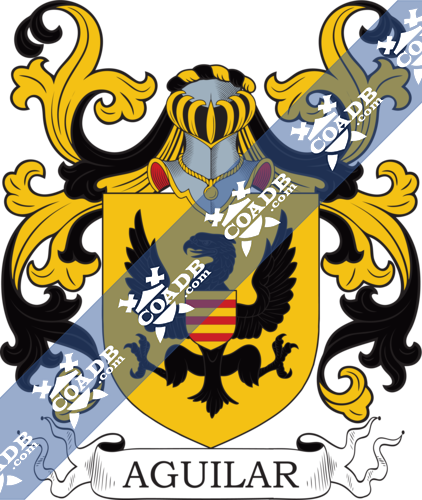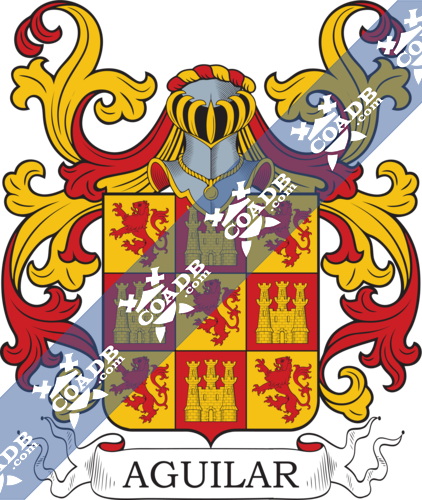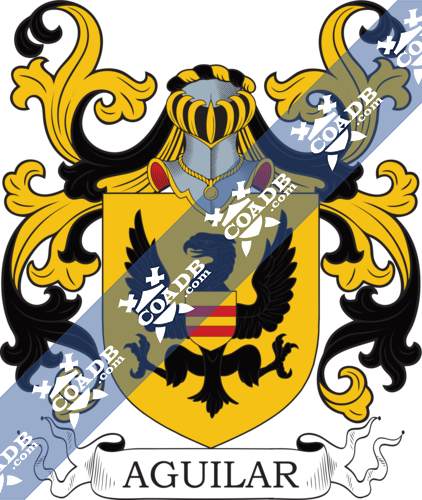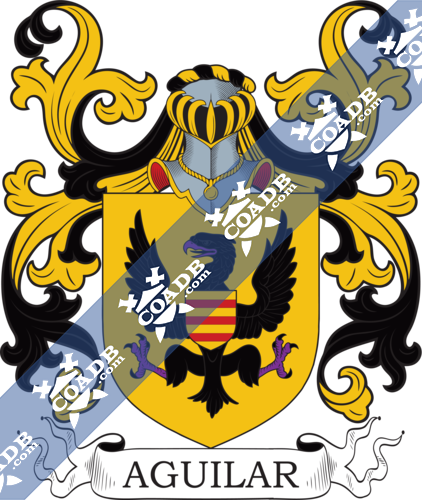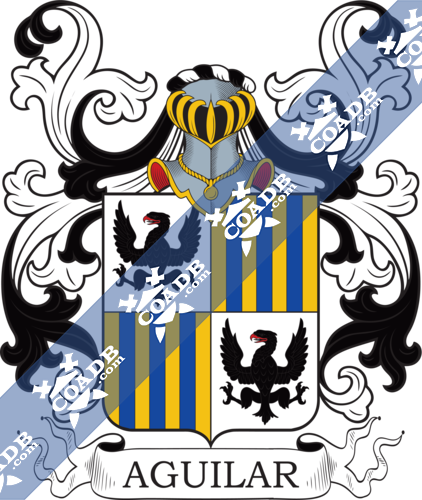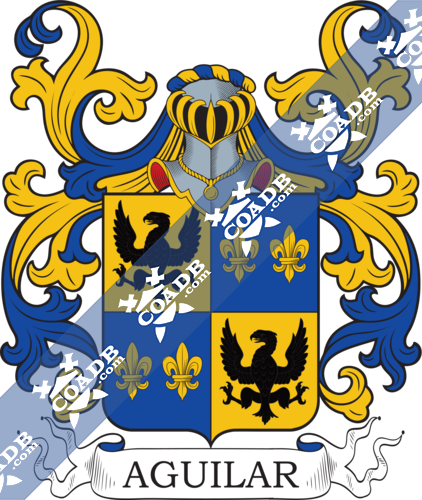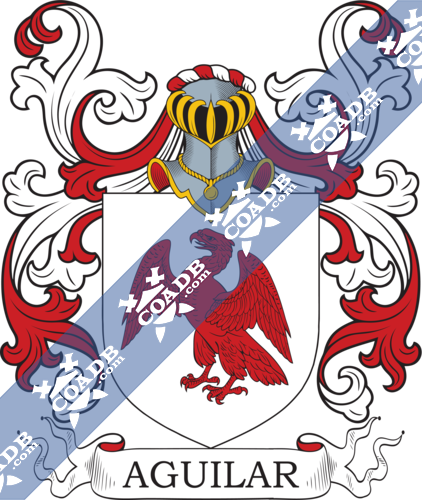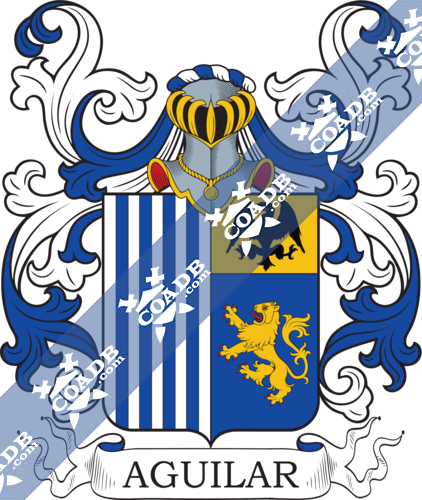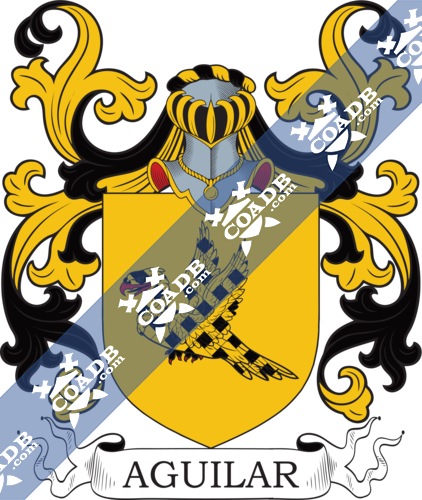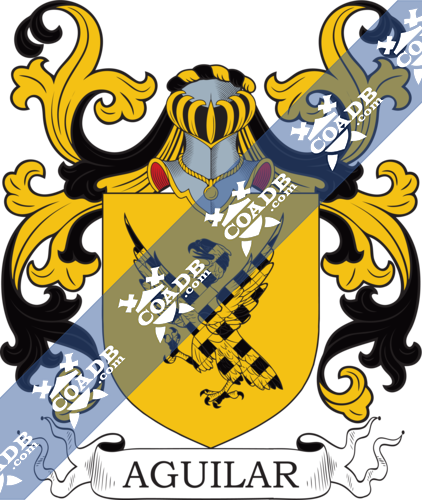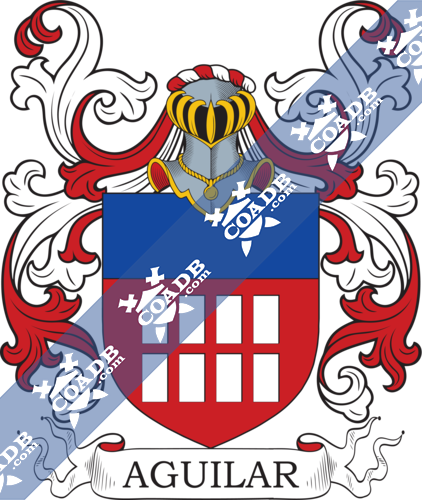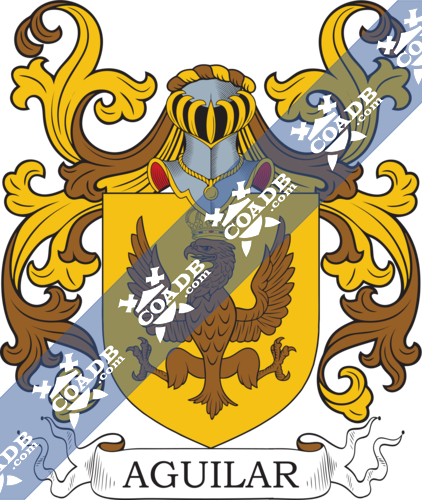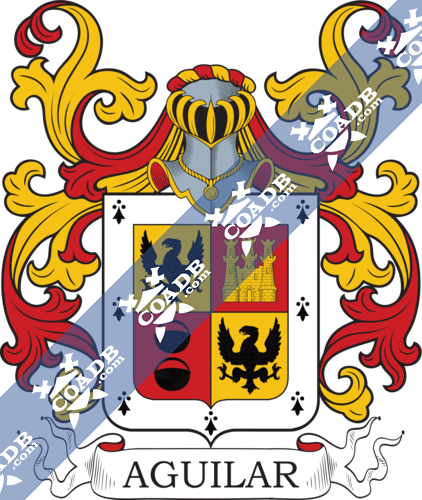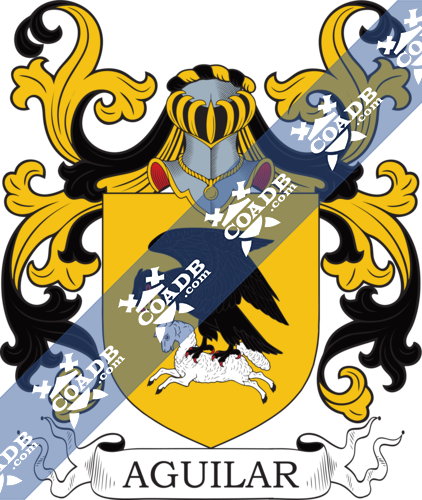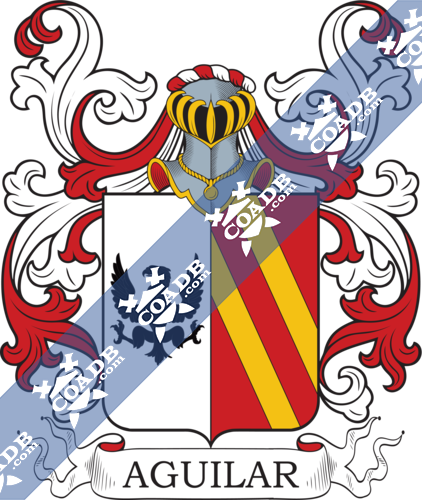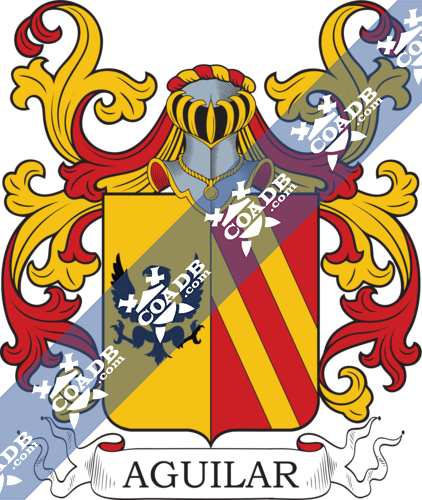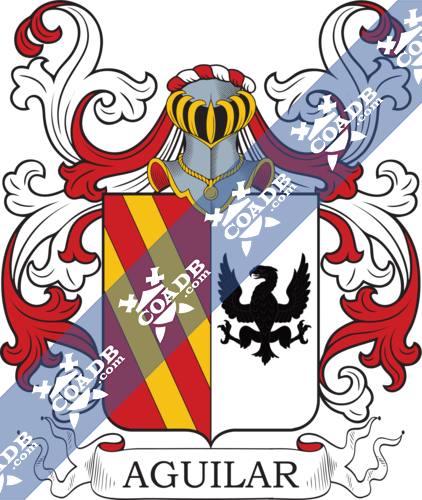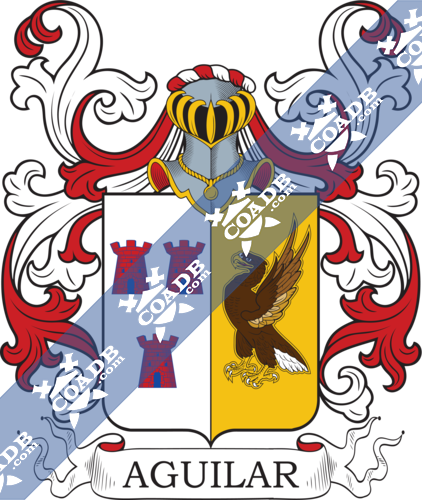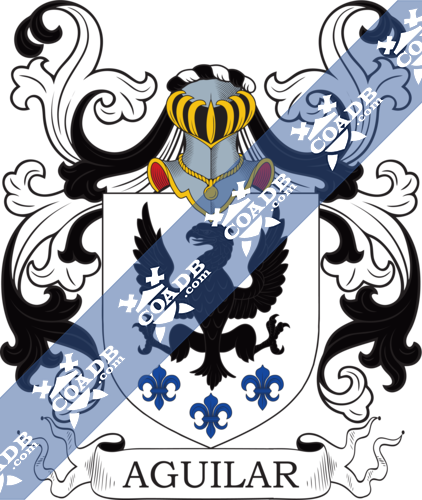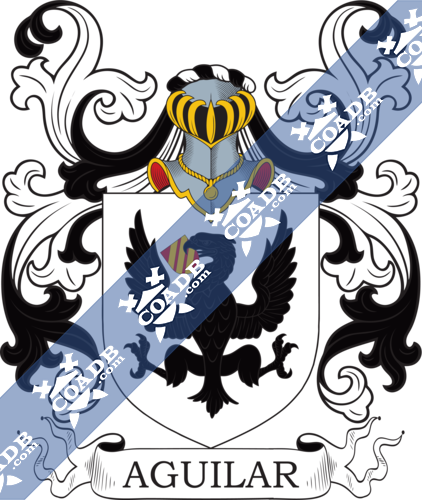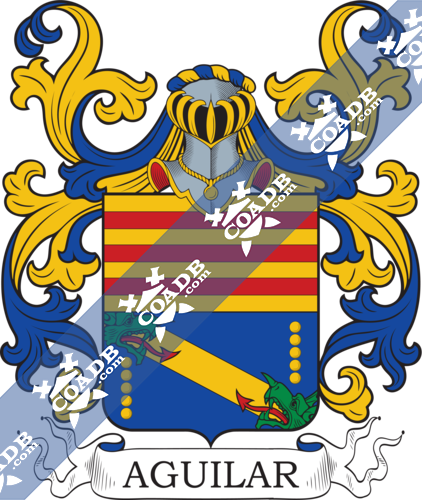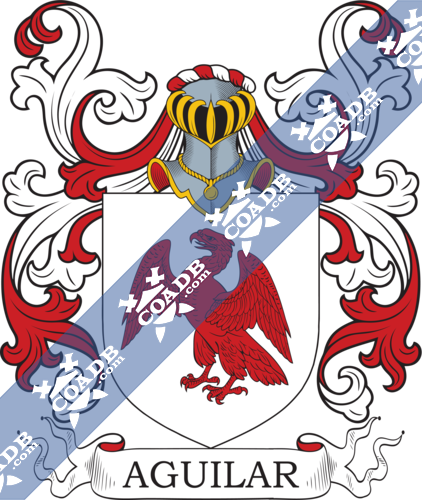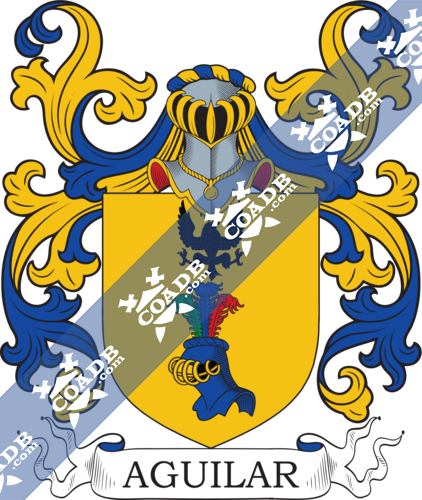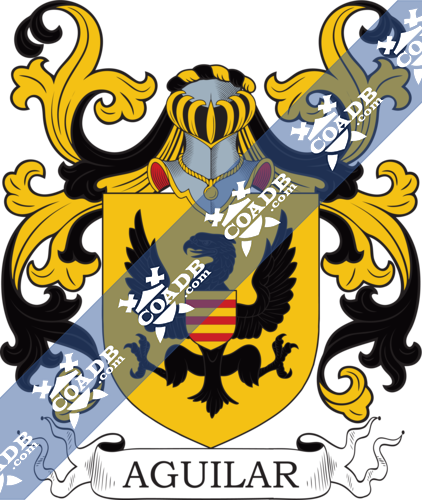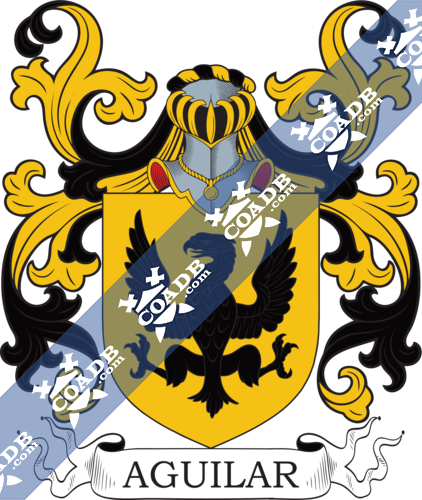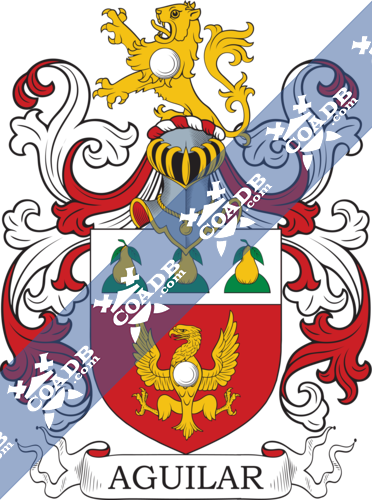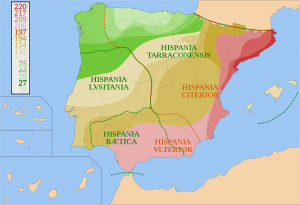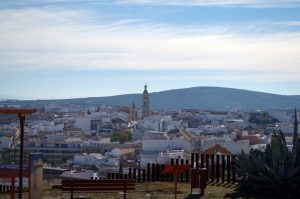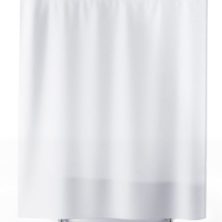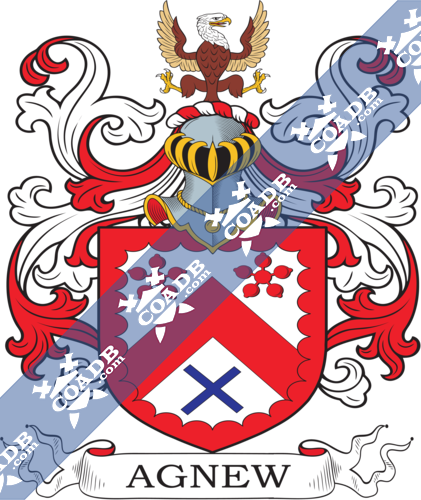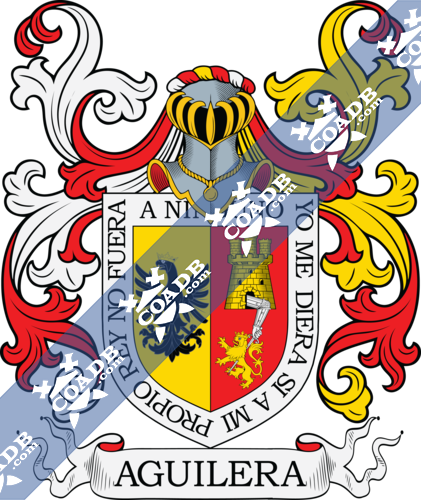Aguilar Family Crest, Coat of Arms and Name History

Aguilar Coat of Arms Gallery
Don’t know which Coat of Arms is yours?
We can do a genealogical research. Find out the exact history of your family!
Learn MoreSurname Meaning, Origin, and Etymology
The surname Aguilar comes from ancient Spain in Europe. It became a popular last name during the Middle Ages, however, its roots can be traced way back to the Roman Empire. The Spanish region was one of the several territories under Roman control. It was like this from around 100 AD until approximately the year 410 AD when the large Roman Empire fell. For this reason, many of the Spanish surnames have a strong influence on the Roman culture and Aguilar is among this kind of family names.
“Aquilaria” is an ancient Roman or Latin word that means “the eagle’s lair”, and it was granted to someone who used to live close to an area with an eagle’s nest. This connection is better appreciated in Spanish because the word eagle is translated “águila”. Habitational surnames were among the first categories of last names that became hereditary. This type of family names is associated with a feature of a certain place, so their inhabitants took the surname and then they passed it to their children and these to theirs.
In time, it was not entirely necessary to live close to an eagle’s nest to use the Aguilar surname. Many cities in Spain were named like that, so a part of their inhabitants started to use it as their family
name. Some of these cities are Aguilar or Aguilar de La Frontera, which was close to Córdoba, Aguilar de Campo in the region of Palencia and Aguilar de Segarra in Barcelona in the Spanish region of Catalonia.
Maybe the oldest region of Spain where this surname can be seen for the first time is Castile, one of the several Christian kingdoms that formed the Iberian Country in its early days. The first record of this last name belonged to Francisco de Aguilar, a steward who served the King Peter III of Aragón, Valencia and Sicilia and count of Barcelona, who lived from 1239 until 1285.
Spelling Variations
With the pass of times, many surnames earned several spelling variations. This phenomenon was very normal because after hundreds of years, different factors had an influence on this kind of words. The reasons were varied. One of them is that a certain branch of the family wanted to be easily distinguished from the others, so they added a certain letter or letters to be unique. Another reason was that a spelling variation was a good way to show to whom a specific side of the family was loyal, like a king or a count.
The most important reason for a spelling variation in a surname was the cultural mix in the region, which in Spain was very complex. The Iberian country was an old region of the Roman Empire, which then it became a European area under Arabic control and previous to these two remarkable civilizations it had its own culture and inhabitants, the Gauls. So, it was not strange for a Spanish surname having many different ways of being written. In the case of Aguilar, some of the most popular spelling variations were: Aguilera, Aguiler, Aguiar, Aquilar and many others.
Popularity & Geographic Distribution
Aguilar is a very popular and widespread surname in the world. It occupies the 334th spot on the most common last names on the planet with approximately 1,460,042 bearers around the globe. Mexico is the country where Aguilar has its highest prevalence, which is very predictable because this country used to be one of the biggest Spanish colonies in America, so the Iberian culture and surnames were common. The United States has the second place on the popularity of Aguilar, followed by Peru on the third. The country with the highest density of bearers of Aguilar is Honduras.
Early Bearers of the Surname
Thanks to the high popularity of Aguilar, there are some good records of the old users of this surname and some of its spelling variations, in Europe and others even in America. One of them was Jerónimo Aguilera, who was a soldier who had a major role in the took of Granada in 1492 and for that, he was rewarded by King Ferdinand and Queen Isabella. Others example are Diego Aguilera, a painter from Spain during the sixteenth century and Juan de Aguilar of Salamanca a noble of that same century.
In Mexico there are a few more early records of Aguilar such as Flores Aguilar of Santa Ana, on July 21, 1778, José Aguilar of the San Diego Mission, California, who got married to Maria López on December 6th, 1781. The first record of Aguilar in Mexico talks about Luis Aguilar in August 24th, 1661 who appears in the register of the Mexican city of Asuncion during the reign of King Philip IV of Spain and also Emperor of Mexico.
History, Genealogy, and Ancestry
As it is said before, Aguilar is a popular surname, but the genealogy records that can be found are not very long. However, Chile is a country with good records of different branches of Aguilar that allow knowing some of the members of several lines of this Spanish surname. One of these genealogical trees begins with Diego Álvarez de Aguilar who in 1636 had a son named Mauricio Pérez de Aguilar with an unknown woman. Mauricio Pérez de Aguilar grew up to become an important admiral who led several expeditions, he got married to Catalina de Barrientos who was the daughter of Álvaro Núñez Barrientos de Ayala and Bernabela de Alvarado y Vargas.
Mauricio and Catalina had four children, the first one was Juan Pérez de Aguilar y Barrientos who got married to Isabel Pérez de Berroeta. Juan and Isabel only had one child, Juan Pérez de Aguilar y Berroeta, who got married to María Nieves de Cárcamo y Gallardo. Juan Pérez de Aguilar y Berroeta and his wife, María had two daughters: Esperanza Pérez de Aguilar y Cárcamo, who was born in 1730 and María Ventura Pérez de Aguilar y Cárcamo who was born in 1736.
The second child of Mauricio Pérez de Aguilar and Catalina Barrientos was Sebastiana Pérez de Aguilar y Barrientos who got married to Miguel Gallardo del Águila y Oyarzún in 1707. The next one was Simón Pérez de Aguilar y Barrientos who was born in 1685 who became an expeditionary and many campaigns. He grew up to get married to Catalina Nieto de la Torre y Cárcamo and they only had one son, José Pérez de Aguilar y Nieto. The fourth and final child of Mauricio Pérez de Aguilar and Catalina Barrientos was Francisco Pérez de Aguilar who didn’t have any children.
Another branch of the surname Aguilar starts with Abel Aguilar Zearte who got married to Emelina Casas Leal. Abel and Emelina only had one child, Alberto Aguilar Casas, who was born in Puerto Octay on August 3rd, 1899. Alberto grew up and got married to Selma Kuschel Villaroel in 1927. She was the daughter of Francisco Kuschel Kruse and Icelia Villarroel y Oyarzún. Alberto and Selma had a long offspring of 13 children. The first one was Héctor René Aguilar Kuschel, who was born in 1928 in Rupanco and got married to Ida Hernández. The next child was Edita Aguilar Kuschel, who was born in Río Negro on January 20th, 1930.
The third child of Alberto Aguilar Casas and Selma Kuschel was Alfonso Aguilar Kuschel, who was born in Purranque on January 29, 1931. Then there was Alberto Segundo Aguilar Kuschel who was also born in Río Negro on January 18, 1932, and then in the same city but in 1934 Nelson Aguilar Kuschel, the fifth child was born. Nelson got married to Elvira Mansilla and together they had four children: Juan Antonio Aguilar Mansilla, Nelson Segundo Aguilar Mansilla, Mónica Aguilar Mansilla and Richard Aguilar Mansilla.
The next child of Alberto Aguilar Casas and Selma Kuschel was Mario Aguilar Kuschel who was also born in Río Negro in 1936 and got married to María del Carmen Vera Álvarez. They had four children Arnoldo Aguilar Vera, Luisa Aguilar Vera, Pascual Aguilar Vera and Juan Aguilar Vera. Back to the main line, the next one is Elizabeth Aguilar Kuschel, born in Río Negro on October 3, 1938, and got married to Sergio Vera Álvarez. The seventh child of Alberto Aguilar Casas and Selma Kuschel was Raquel Aguilar Kuschel who was born in Río Negro on November 1, 1940 and got married to Daniela Lara Ortiz. Then, there was Ilse Aguilar Kuschel who was born in Río Negro on October 11th, 1943, who got married to Juan Ojeda Ojeda, for a first time and in a second time with an unknown man.
The tenth child of Alberto Aguilar Casas and Selma Kuschel was Egon Andrés Aguilar Kuschel who just like most of his brothers and sisters, was born in Río Negro on February 2nd, 1946, and got married to Silvia Vera Álvarez. This couple had four children: Silvia Aguilar Vera, Cecilia Aguilar Vera, Andrea Aguilar Vera and Egon Aguilar Vera.
After Egon Andrés Aguilar Kuschel, came Carlos Ronald Aguilar Kuschel, who was born on May 8th, 1949 also in the city of Río Negro. Then, there was Selma Luisa Aguilar Kuschel who was born in Río Negro on November 7, 1950 and got married to José Romeli Espinoza. The last child of Alberto Aguilar Casas and Selma Kuschel was Silvia Isolde Aguilar Kuschel, who was born in Río Negro on August 2nd in 1954 and got married to Rafael Lara Palma.
A third branch of the Aguilar last name belongs to Isidro Aguilar Vargas who started his line with his wife, Toribia Gallardo Vargas. They had seven children, the first one was María Trinidad Aguilar Gallardo, who was born in Vilupulli on June 8 ¡, 1800 and got married to Silvestre Andrade Oyarzún on January 22, 1825. The second child of Isidro and Toribia was Miguel Aguilar Gallardo born on March 3rd, 1802. Then, there was María Silveria Aguilar Gallardo who was born on August 5th, 1804 and got married to Guillermo Pérez Sánchez. The following child of Isidro and Toribia was Antonio Aguilar Gallardo, who was born on January 19, 1811, and got married to Ventura Gómez Hernández, with whom he had a child: José María Aguilar Gómez, born September 16, 1848.
This line of Aguilar continues with Juan Aguilar Gallardo, who was born on September 18, 1808, and got married twice. The first time to Melchora Oyarzún and the second to Margarita Andrade Gómez. Then Francisco Aguilar Gallardo was born on May 18, 1821, and finally, Mariano Aguilar Gallardo, who was born in 1825.
Early American and New World Settlers
After the arrival of Christopher Columbus at America, many Europeans wanted to start a new life in the recently discovered continent. It was a good opportunity to try a new life where anything was possible. It was thanks to this big movement of people, that the culture of the old world arrives in America and part of that culture were the surnames, after all, it was a big element of the identity of the people. Some of the first bearers of Aguilar in arriving in America during the 16th century were: Jerónimo Aguilar who arrived at the coast of México in 1511, Antonio Aguilar who arrived Venezuela in 1534, Juan Aguilar who did the same in Florida in 1538, Diego Aguilar y Contreras who arrived at Chile in 1562 and Beatriz de Aguilar who landed in Peru in 1592.
There are no records of users of Aguilar arriving in America during the 17th century and in the 18th century, there is an only record, Moses Aguilar who landed in 1746. At the next century, the 19th century, there are some good records that allow knowing some of the bearers of Aguilar like José Aguilar who arrived in Puerto Rico in 1802, at the next year Andres Aguilar also landed in Puerto Rico, then at 1811, Juan de Aguilar arrived in America in 1812.
Notables
There have been some remarkable users of the Aguilar surname or of its spelling variations. Some of them are: Natasha Aguilar Komisorava (1970-2016) a free style swimmer from Costa Rica who won silver and bronze medals, José Aguilar Pulsar (1958-2014) who was Cuban boxer that won Light Welterweight bronze medal during the Olympics of 1980, Gustavo Adrián Ruelas Aguilar (b. 1991) an American soccer player, Japeth Paul C. Aguilar (b. 1987) a basketball player from Philipines, Grace Aguilar (1816-1847), English novelist and writer, Eduardo Demetrio Bravo Aguilar (b. 1920), important lawyer from Argentina and Antonio Aguilar Barraza (1092-2007) an actor, singer, producer and writer from Mexico, Abel Aguilar (b. 1985) a football player from Colombia, Luis Aguilar Monsalve (b. 1942) a Ecuadorian writer, Eugenia Aguilar (1804-1879) President of El Salvador (1846-1848), Jorge Aguilar (b. 1985) a tennis player from Chile and Samuel Aguilar (1933-2013) a football player from Paraguay.
Blazons & Genealogy Notes
1) Espagne – De gueules à l’aigle de sable tenant en son bec un écusson de gueules ch de trois barres d’or
2) Estrémadure – D’or à l’aigle de sable
3) Portugal – D’or à l’aigle de gueules becquée et membrée de sable et un grand croissant d’argent passant sur les ailes et les pieds de l’aigle
4) (Marquis) – Espagne – Cinq points d’or ch chacun d’un lion de gueules équipollés à quatre points de gueules ch chacun d’un château d’or
5) Castille – D’or à l’aigle éployée de couleur brunâtre surmontée d’une couronne royale d’or
6) Catalogne – D’argent à l’aigle de profil de gueules le vol ouvert et abaissé
7) de Aguilar – Londres, Espagne, Portugal – De gueules à l’aigle d’or surmontée d’un besant d’argent au chef du même ch de trois collines de sinople sommées chacune d’une poire d’or tigée et feuillée de sinople Cimier un lion issant d’or ch d’un besant d’argent
8) Aguilar Y Córdoba – Estrémadure – D’or à l’aigle de sable ch sur l’estomac d’un écusson aux armes de Córdoba qui sont d’or à trois fasces de gueules
9) El solar de Aguilar de Campóo del que procedieron las casas de Navarra, Aragón, Cataluña, Valencia, La Rioja, Guadalajara, Asturias, Extremadura y Galicia traen: En campo de oro, un águila de sable. También traen las mismas armas muchas líneas de Aragón, entre otras las procedentes de las casas solares de Calaceite y de Aguilar de alfambra, en la provincia de Teruel, y de Robres, en la provincia de Huesca. Esta mismas armas usan los de Segovia.
10) Las armas primitivas de los de este linaje de Aguilar, esto es, la de Gonzalo Yánez, primer Señor del Estado de Aguilar, eran: En campo de oro, tres palos de gules.
11) Las armas primitivas las cambio el citado Gonzalo Yáñez al serle concedido el Señorío de Aguilar por estas otras: En campo de oro, un águila de sable, exployada, y con corona imperial. Estas armas las traen también los Aguilar de Castilla la Nueva y de Castilla la Vieja. Así traen también sus armas los Aguilar de Extremadura y los de Granada.
12) Las armas de la línea que radicó en la villa de Yepes, de la provincia de Toledo, traen: En campo de plata, un águila de sable, exployada, y con corona imperial.
13) Los de la casa de Écija, traen: En campo de plata, un águila de sable, con corona ducal de oro.
14) Los Aguilar de Barcelona, según Xavier de Garma, traen: En campo de oro, un águila, de sable, coronada de oro.
15) Las de Arnaldo de Aguilar que estuvo con don Jaime I de Aragón, en la conquista de Valencia, traen: En campo de plata, un águila de gules.
“16)
Otros traen: En campo de oro, un águila de sable; bordura componada de cinco piezas de oro y otras cinco de sable.”
17) La casa de Tarazona y los de Borja, traen: En campo de oro, un águila explayada, de sable; bordura componada de cinco piezas de oro y otras cinco de sable.
18) La casa de Coscojuela de Fantova y los de Campo, Naval, Colungo, Buera, Robres, y varias poblaciones aragonesas, traen: Escudo partido: 1º, en campo de azur, una flor de lis, de oro, y 2º, en campo de oro, un águila explayada, de sable.
19) Otros Aguilar, de Coscojuela de Fantova y los de Campo, Naval, Colungo, Buera, Robres, y varias poblaciones aragonesas, traen: Escudo partido: 1º, en campo de azur, una flor de lis, de plata, y 2º, en campo de oro, un águila explayada, de sable.
20) Otra casa de Borja, trae: Escudo cuartelado: 1º y 4º, en campo de oro, un águila de sable, y 2º y 3º, en campo de azur, una flor de lis, de oro.
21) La rama de Vizcaya, según el Cronista Francisco Gómez de Arévalo, traen: En campo de gules, dos calderas, de oro, con siete cabezas de sierpe cada caldera, cuatro a la diestra y tres a la siniestra.
22) Otros de Cataluña, traen: En campo de oro, un águila de azur; bordura dentellada también de azur.
23) Los de la casa solar de la ciudad de Seo de Urgel, en la provincia de Lleida, traen: Escudo de oro, con un águila de sable; cortado de plata con dos palos de azur, y medio partido, de azur, con un león rampante, de oro, membrado de gules.
24) Otros de la citada ciudad de Seo de Urgel, traen: Escudo partido: 1º, en campo de plata, cuatro palos de azur, 2º, en campo de azur, un león rampante y linguado, de gules, el jefe de oro, con un águila de sable.
25) Otros de la citada ciudad de Seo de Urgel, traen: Escudo partido: 1º, en campo de plata, cuatro palos de azur, 2º, en campo de azur, un león rampante y linguado, de gules, el jefe de oro, con un águila de sable membrada y picada de gules.
26) La casa de Aguilar, Condes de Castañeda, trae: Escudo cuartelado: 1º y 4º, de plata, con un castillo de gules, y 2º y 3º, también de plata, con un águila de sable, coronada de oro; bordura de plata, con trece armiños de sable.
27) Según un escudo del Palacio de la familia Aguilar, en la calle Montcada de Barcelona, constan las siguientes: En campo de oro, un águila de sable, con las alas bajadas, coronada de oro.
28) Otros de Aragón, traen: En campo de plata, un águila de gules, en acción de emprender el vuelo.
29) Los Aguilar España, de Santiago de Galicia, usan estas otras armas: En campo de plata, un racimo de uvas de sinople.
30) Diego Ramírez de Avalos señala este escudo para los de Navarra: En campo de oro, un águila de sable, armada de gules.
31) Otros, según el Cronista Jorge de Montemayor: En campo de oro, tres fajas de gules.
32) Otros, según el Cronista Jorge de Montemayor: En campo de oro, tres fajas de sable.
33) Otros, según Miguel de Salazar: Escudo fajado de seis piezas de oro y gules.
34) Los de Agreda (Soria), según el Cronista Juan Alfonso de Guerra y Sandoval: En campo de azur, dos flores de lis de oro.
35) Otros, según el Cronista Vidal: En campo de azur, un águila de plata, linguada de gules, y picada y membrada de oro.
36) Los de Valencia, traen: En campo de oro, un águila de sable, con las alas desplegadas, membrada de oro y armada de sable.
37) Otros, según el Cronista Jorge de Montemayor: En campo de oro, un águila de sable volante.
38) Otros, según Agustín de Loaysa: En campo de oro, un águila volante de sable; bordura con el cordón de San Francisco.
39) La casa de Aguilar y Córdoba y sus líneas ostentan: En campo de oro, un águila de sable, que es de Aguilar, y en el pecho del águila un escusón de oro, con tres fajas de gules, que es de Córdoba.
40) La casa de Aguilar y Córdoba y sus líneas ostentan: En campo de oro, un águila de sable, que es de Aguilar, y en el pecho del águila un escusón de oro, con dos fajas de gules, que es de Córdoba.
41) La casa de Aguilar y Córdoba y sus líneas ostentan: En campo de oro, un águila de sable, picada y membrada de púrpura, que es de Aguilar, y en el pecho del águila un escusón de oro, con tres fajas de gules, que es de Córdoba.
42) Johan de Aguilar, Cofrade de Santiago, usaba por armas: Escudo cuartelado: 1º y 4º, en plata, un águila de sable, picada de gules, y 2º y 3º, en oro, tres palos de azur.
“43)
El Arzobispo de Toledo, Gonzalo Aguilar, según el Cronista Juan Alfonso de Guerra y Sandoval, usaba: Escudo cuartelado: 1º y 4º, en campo de oro, un águila de sable, y 2º y 3º, en campo de azur, dos flores de lis de oro”
44) Otros de Cataluña, según J.-B. Ritstap, traen: En campo de plata, un águila de gules, puesta de perfil, con las alas hacia abajo.
45) La casa de Aguilar, de Orgañá (Lérida), usa: Escudo partido: 1º, en campo de plata, cuatro barras de azur, y 2º, en campo de azur, un león rampante de oro, linguado y armado de gules, y jefe de oro, con un águila de sable con las alas extendidas y bajadas, picada y armada de gules.
46) Lorenzo señala para la casa de Navarra: En campo de oro, un águila de sable, gritada de oro, volante y armada de gules.
47) El Cronista Fray Prudencio de Sandoval señala para el castillo de Aguilar, cerca del Reino de Navarra, con ramas en Castilla y Andalucía, las siguientes armas: En campo de oro, un águila de sable, rampante, con las alas desplegadas, gritada de oro.
48) Los de Mixa, según Juan Carlos de Guerra: Escudo de gules, con el jefe cosido, de azur, y cargado de ocho billetes de plata, en dos fajas.
49) Otras ramas procedentes del solar primitivo de Aguilar de Campóo ostentan el siguiente escudo: En campo de oro, un águila de sable; bordura con ocho dentellones de sable.
50) Otros traen: Escudo cuartelado: 1º y 4º, de oro, con un águila de sable, 2º, de gules, con un castillo de oro, y 3º, también de gules, con dos calderas de sable, una sobre otra; bordura de plata, con ocho armiños de sable.
51) Los radicados en La Coruña, según Vicente de Cadenas: En campo de oro, un águila, de sable, con un cordero, de plata, en sus garras, linguada y uñada de gules.
52) Los de Cardona (Barcelona), según el Cronista Juan Alfonso de Guerra y Sandoval, usaron: Escudo partido: 1º, en campo de plata, un águila de sable, y 2º, en campo de gules, dos bastones de oro.
53) Los de Cardona (Barcelona), según el Cronista Juan Alfonso de Guerra y Sandoval, usaron: Escudo partido: 1º, en campo de oro, un águila de sable, y 2º, en campo de gules, dos bastones de oro.
54) Los de Ecija (Sevilla), según el Cronista Juan Alfonso de Guerra y Sandoval: Escudo partido: 1º, en gules, dos bastones de oro, 2º, en plata, un águila de sable.
55) Otros, de Valencia, traen: Escudo partido: 1º, en campo de plata, tres torres de gules, aclaradas, almenadas y mazonadas de azur, bien ordenadas, y 2º, en campo de oro, un águila alzada en actitud de volar, perfilada de oro.
56) Otros traen: En campo de plata, un águila de sable, y debajo tres flores de lis de azur.
57) Otros, según Miguel de Salazar, usan: En campo de plata, un águila de sable, con dos árboles de sinople, sujetando cada pie a un árbol.
58) Otros, según Johan Baptiste Rietstap, traen: En campo de gules, un águila de sable, que sostiene con su pico un escusón de gules, cargado de tres barras de oro.
59) Otros traen: Escudo cortado: 1º, en oro, tres fajas de gules, y 2º, en azur, una banda de oro, engolada en dragantes de sinople, linguados de gules, acompañada a cada lado de cinco bezantes de oro en palo. Soporte: Un águila de sable coronada.
60) Otros ponen: En campo de oro, una celada de azur mirando a la diestra, con plumas de diversos colores y cinco grilletes de oro, surmontada de un águila de sable, coronada de lo mismo.

